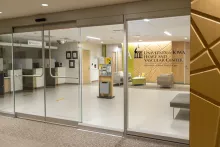Peripheral Artery Disease
- For all other requests:
- 1-800-777-8442
If you have severe PAD that requires more aggressive care, we can help with that, too. Our vascular surgeons offer the full range of medical and surgical treatment options. These options range from chronic wound care to minimally invasive procedures such as stent placement.
We also offer second opinions and second chances. We’re often able to treat people who were told their only remaining treatment option is a foot or leg amputation.
No matter how advanced your PAD, you can count on the UI Heart and Vascular Center to help you get back on your feet and back to better health.
Peripheral artery disease symptoms
The peripheral arteries include blood vessels that carry blood from your heart to your arms and legs. If these arteries become clogged with plaque (atherosclerosis), it’s harder for blood to flow through them and reach your extremities. This leads to pain and other problems, especially in the legs.
Common symptoms of PAD include:
- Change of color in one or both legs
- Claudication (leg pain and cramping that occurs with exercise)
- Coldness in the lower leg or foot, especially on one side
- Ischemic ulcers (open, poorly healing sores on the legs or feet)
- Leg numbness or weakness
- Severe pain in the lower leg or foot even while at rest
If you have leg pain or achiness, don’t assume it’s a normal part of aging, especially if your pain makes it hard to walk or you also have leg or foot wounds. When left untreated, PAD can cause life- and limb-threatening complications. But if you partner with a specialist who can help you address the underlying cause of your PAD, you can reduce or even reverse your symptoms.
Peripheral artery disease diagnosis
If you or your doctor thinks your symptoms are caused by PAD, you should ask for a referral to, or schedule a consultation with, a cardiologist or vascular surgeon.
Without proper diagnosis and treatment, PAD can cause dangerous complications. These include:
- Gangrene (tissue death), which may require foot or leg amputation
- Heart attack
- Stroke
The UI Heart and Vascular Center offers all the tests you might need to identify PAD and determine how advanced it is. These include ankle/brachial index (ABI) tests, angiograms, and vascular ultrasounds
Peripheral artery disease treatment from the UI Heart and Vascular Center
The treatments you'll need for PAD depends on several factors. These include the severity of plaque build-up in your peripheral arteries and the severity of your symptoms.
Nonsurgical PAD treatments
If you have slight narrowing of the peripheral arteries and mild symptoms, nonsurgical treatments may be all you need to feel better. These treatments include:
- Lifestyle changes: You can significantly improve your PAD symptoms and prevent your condition from getting worse by making lifestyle changes. These include exercising, losing weight, quitting smoking, and getting Type 2 diabetes under control.
- Medication: Prescription drugs can help you lower your blood pressure or cholesterol, which lowers your risk of PAD. Some drugs help prevent blood clots or plaque build-up in your blood vessels. And other drugs reduce leg pain caused by PAD, so you can walk farther and more easily.
- Cardiac rehab: Our medically supervised cardiac rehab program, which includes a 12-week customized exercise plan, provides the support you need to improve your heart and vascular health. We can help you create a structured walking program that allows you to walk greater distances over time.
- Wound care: Our vascular surgeons are trained to treat ischemic ulcers and other chronic wounds caused by PAD, so you don’t need to see a separate wound care specialist.
Minimally invasive PAD procedures
If nonsurgical treatments don’t help, or your symptoms make it hard to walk or sleep, you may need more advanced care.
The UI Heart and Vascular Center’s vascular surgeons offer minimally invasive treatment options that can help you recover more quickly and with less pain. These options, which are also known as endovascular procedures, include:
- Angioplasty: We guide a flexible tube (catheter) into the problem artery, then inflate a special balloon. The balloon flattens any plaque and widens the artery so blood can flow through more easily.
- Stent placement: We use a catheter to insert a tiny mesh tube (stent) inside a narrowed artery. Once the stent is in place, it keeps the artery propped open.
- Thrombolysis: This procedure gets rid of blood clots inside the peripheral arteries. Your provider will either dissolve the clot by injecting medication into the artery or break up the clot and suction it out using a special machine.
PAD surgery
In some cases—especially among people with severe PAD—vascular surgery is the best treatment option. That’s because endovascular procedures like angioplasty may not work if a peripheral artery is completely clogged with plaque. In those cases, there is no longer room for a catheter to squeeze through it.
Our surgical areas of expertise include:
- Endarterectomy: We make an incision in your leg, near the problem artery. Then we open the artery and remove the plaque that’s built up inside.
- Vascular bypass surgery: We take one of your own healthy blood vessels, or we create a new one with synthetic material, and attach both ends to the clogged artery. This allows blood to bypass the blockage.
Get a second opinion about limb amputation
If you have advanced PAD with severe chronic wounds, you may have been told your only remaining treatment option is foot or leg amputation. If this is the case, you should request a second opinion with UI Health Care.
We’re home to some of Iowa’s most experienced vascular surgeons, and we offer aggressive PAD treatments that aren’t widely available. In some cases, as long as we intervene quickly, we can perform procedures that significantly improve blood and oxygen circulation in your legs and feet.
Along with proper wound care, these advanced measures can enhance wound healing and prevent further tissue death to help you avoid amputation.
Our Care Team

- Cancer
- Radiology

Need help choosing a PAD specialist?
Locations and Offices
